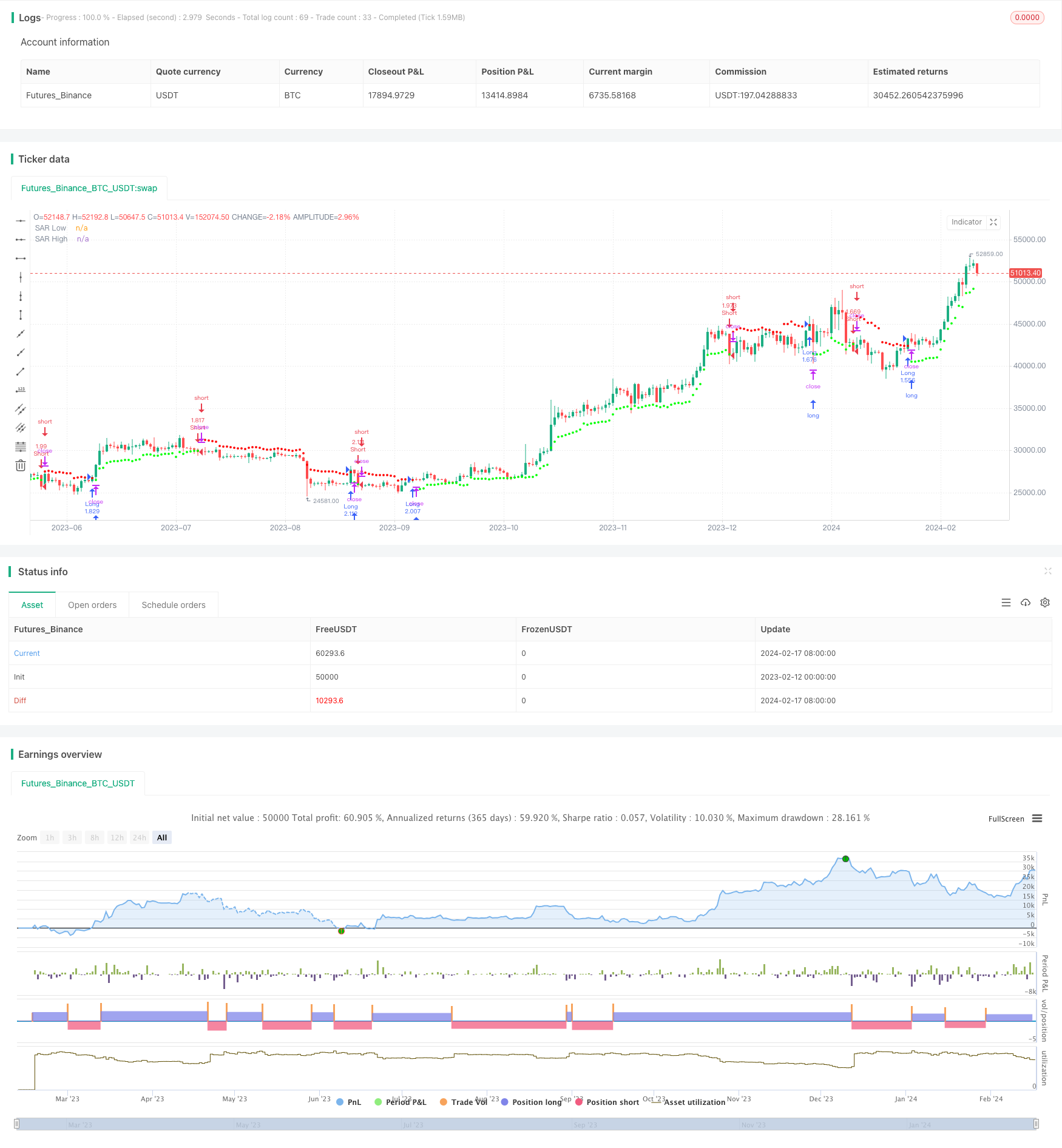
概述
通道突破反转交易策略是一种追踪价格通道的移动止盈止损点的反转交易策略。它利用加权移动平均方法计算价格通道,并在价格突破通道时建立多头或空头头寸。
策略原理
该策略首先利用Wilder平均真实范围(ATR)指标计算价格波动率。然后根据ATR值计算出平均范围常数(ARC)。ARC即为价格通道的一半宽度。接着计算出通道的上轨和下轨,即止盈止损点,称为SAR点。当价格突破上轨时做空,突破下轨时做多。
具体来说,首先计算最近N根K线的ATR。然后用一个系数乘以ATR得到ARC。ARC乘以系数可以控制通道的宽度。ARC加到N根K线里收盘价最高点上得到通道上轨,即高SAR。ARC减去收盘价最低点得到通道下轨,即低SAR。如果价格收盘突破上轨,则做空;如果收盘突破下轨,则做多。
策略优势
- 利用价格波动率计算自适应通道,可以跟踪市场变化
- 反转交易,适合趋势反转市场
- 移动止盈止损,可以锁定利润,控制风险
策略风险
- 反转交易容易被套,需要适当调整参数
- 大幅度波动市场中容易被关闭头寸
- 参数不当会造成过于频繁交易
解决方法:
- 优化ATR周期和ARC系数,使通道宽度合理
- 结合趋势指标过滤进入时机
- 增大ATR周期,降低交易频率
策略优化方向
- 优化ATR周期和ARC系数
- 增加开仓条件,比如结合 MACD 指标
- 增加止损策略
总结
通道突破反转交易策略利用通道追踪价格变化,在波动加剧时反转建仓,并设置自适应移动止盈止损。这种策略适用于反转为主的盘整市场,在判断反转点准确的前提下,可以获得不错的投资回报。但需要注意防止止损点过于宽松和参数优化问题。
策略源码
/*backtest
start: 2023-02-12 00:00:00
end: 2024-02-18 00:00:00
period: 1d
basePeriod: 1h
exchanges: [{"eid":"Futures_Binance","currency":"BTC_USDT"}]
*/
//@version=3
//@author=LucF
// Volatility System [LucF]
// v1.0, 2019.04.14
// The Volatility System was created by Welles Wilder.
// It first appeared in his seminal masterpiece "New Concepts in Technical Trading Systems" (1978).
// He describes it on pp.23-26, in the chapter discussing the first presentation ever of the "Volatility Index",
// which later became known as ATR.
// Performance of the strategy usually increases with the time frame.
// Tuning of ATR length and, especially, the ARC factor, is key.
// This code runs as a strategy, which cannot generate alerts.
// If you want to use the alerts it must be converted to an indicator.
// To do so:
// 1. Swap the following 2 lines by commenting the first and uncommenting the second.
// 2. Comment out the last 4 lines containing the strategy() calls.
// 3. Save.
strategy(title="Volatility System by Wilder [LucF]", shorttitle="Volatility System [Strat]", overlay=true, precision=8, pyramiding=0, initial_capital=100000, default_qty_type=strategy.percent_of_equity, default_qty_value=100, commission_type=strategy.commission.percent, commission_value=0.1)
// study("Volatility System by Wilder [LucF]", shorttitle="Volatility System", precision=8, overlay=true)
// -------------- Colors
MyGreenRaw = color(#00FF00,0), MyGreenMedium = color(#00FF00,50), MyGreenDark = color(#00FF00,75), MyGreenDarkDark = color(#00FF00,92)
MyRedRaw = color(#FF0000,0), MyRedMedium = color(#FF0000,30), MyRedDark = color(#FF0000,75), MyRedDarkDark = color(#FF0000,90)
// -------------- Inputs
LongsOnly = input(false,"Longs only")
ShortsOnly = input(false,"Shorts only")
AtrLength = input(9, "ATR length", minval=2)
ArcFactor = input(1.8, "ARC factor", minval=0, type=float,step=0.1)
ShowSAR = input(false, "Show all SARs (Stop & Reverse)")
HideSAR = input(false, "Hide all SARs")
ShowTriggers = input(false, "Show Entry/Exit triggers")
ShowTradedBackground = input(false, "Show Traded Background")
FromYear = input(defval = 2000, title = "From Year", minval = 1900)
FromMonth = input(defval = 1, title = "From Month", minval = 1, maxval = 12)
FromDay = input(defval = 1, title = "From Day", minval = 1, maxval = 31)
ToYear = input(defval = 9999, title = "To Year", minval = 1900)
ToMonth = input(defval = 1, title = "To Month", minval = 1, maxval = 12)
ToDay = input(defval = 1, title = "To Day", minval = 1, maxval = 31)
// -------------- Date range filtering
FromDate = timestamp(FromYear, FromMonth, FromDay, 00, 00)
ToDate = timestamp(ToYear, ToMonth, ToDay, 23, 59)
TradeDateIsAllowed() => true
// -------------- Calculate Stop & Reverse (SAR) points using Average Range Constant (ARC)
Arc = atr(AtrLength)*ArcFactor
SarLo = highest(close, AtrLength)-Arc
SarHi = lowest(close, AtrLength)+Arc
// -------------- Entries/Exits
InLong = false
InShort = false
EnterLong = TradeDateIsAllowed() and not InLong[1] and crossover(close, SarHi[1])
EnterShort = TradeDateIsAllowed() and not InShort[1] and crossunder(close, SarLo[1])
InLong := (InLong[1] and not EnterShort[1]) or (EnterLong[1] and not ShortsOnly)
InShort := (InShort[1] and not EnterLong[1]) or (EnterShort[1] and not LongsOnly)
// -------------- Plots
// SAR points
plot( not HideSAR and ((InShort or EnterLong) or ShowSAR)? SarHi:na, color=MyRedMedium, style=circles, linewidth=2, title="SAR High")
plot( not HideSAR and ((InLong or EnterShort) or ShowSAR)? SarLo:na, color=MyGreenMedium, style=circles, linewidth=2, title="SAR Low")
// Entry/Exit markers
plotshape( ShowTriggers and not ShortsOnly and EnterLong, style=shape.triangleup, location=location.belowbar, color=MyGreenRaw, size=size.small, text="")
plotshape( ShowTriggers and not LongsOnly and EnterShort, style=shape.triangledown, location=location.abovebar, color=MyRedRaw, size=size.small, text="")
// Exits when printing only longs or shorts
plotshape( ShowTriggers and ShortsOnly and InShort[1] and EnterLong, style=shape.triangleup, location=location.belowbar, color=MyRedMedium, transp=70, size=size.small, text="")
plotshape( ShowTriggers and LongsOnly and InLong[1] and EnterShort, style=shape.triangledown, location=location.abovebar, color=MyGreenMedium, transp=70, size=size.small, text="")
// Background
bgcolor( color=ShowTradedBackground? InLong and not ShortsOnly?MyGreenDarkDark: InShort and not LongsOnly? MyRedDarkDark:na:na)
// ---------- Alerts
alertcondition( EnterLong or EnterShort, title="1. Reverse", message="Reverse")
alertcondition( EnterLong, title="2. Long", message="Long")
alertcondition( EnterShort, title="3. Short", message="Short")
// ---------- Strategy reversals
strategy.entry("Long", strategy.long, when=EnterLong and not ShortsOnly)
strategy.entry("Short", strategy.short, when=EnterShort and not LongsOnly)
strategy.close("Short", when=EnterLong and ShortsOnly)
strategy.close("Long", when=EnterShort and LongsOnly)